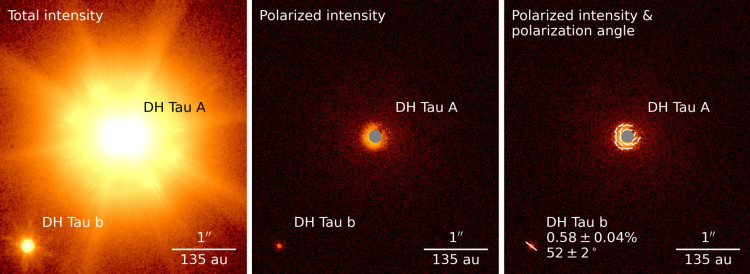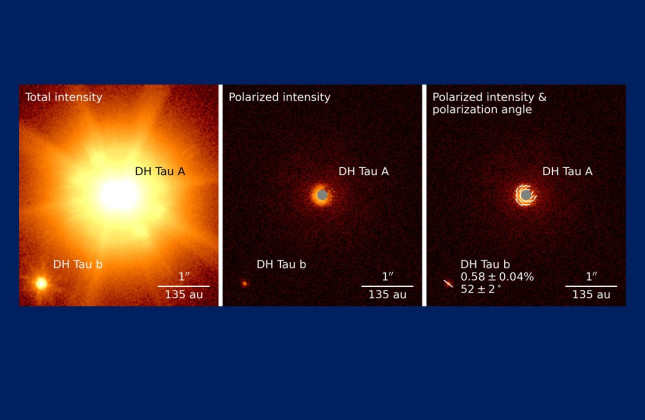The discovery concerns the exoplanet DH Tau b. This is a very young planet of only 2 million years old at 437 light years from Earth in the constellation Taurus. Exoplanet DH Tau b does not resemble our Earth. The planet is at least eleven times more massive than Jupiter, the most massive planet in our solar system. The planet is also located ten times further away from its star than our furthest planet Neptune. The planet is still glowing after its formation. As a result, it emits heat in the form of infrared radiation.
The researchers discovered that the infrared radiation of the planet is polarized. This means that the light waves vibrate in a preferential direction. And that, according to the researchers, is because the infrared radiation of the planet is scattered by a disk of dust and gas that orbits the planet. In such a disk, moons may form.
Furthermore, the disk around the planet appears to have a different orientation from the disk around the star. Such a tilted disk indicates that the planet has likely formed at a large distance from the star. This is contrary to the theory that planets are formed close to their star and then migrate outward.
Story continues below image. Three images of the exoplanet DH Tau b. The left image shows all light, both unpolarized and polarized. The middle image shows only polarized light. The right image additionally shows the direction of the polarized light. In polarized light the planet DH Tau b is visible, which points to a disk of dust and gas around this planet. The disk around the star is also visible. (c) ESO/VLT/SPHERE/Van Holstein et al.
Three images of the exoplanet DH Tau b. The left image shows all light, both unpolarized and polarized. The middle image shows only polarized light. The right image additionally shows the direction of the polarized light. In polarized light the planet DH Tau b is visible, which points to a disk of dust and gas around this planet. The disk around the star is also visible. (c) ESO/VLT/SPHERE/Van Holstein et al.
SPHERE instrument
For the observations, the astronomers used the SPHERE instrument on the Very Large Telescope of the European Southern Observatory (ESO) in Chile. This instrument can, among other things, block the overwhelming light of the associated star and determine the polarization of the remaining light.
First author and research leader Rob van Holstein (Leiden University, the Netherlands) has been working with the SPHERE instrument since his university study in 2014: "Because we fully understood the instrument, we were able to make it perform better than it was designed for. In the end, we were able to capture the light from twenty exoplanets, one of which had polarized light."
Co-author Frans Snik (Leiden University) has been trying to capture polarized light from planets since 2012: "It's already very special that we can see a planet separated from the star around which it orbits. And now we can also deduce that material is orbiting this planet as well, and that this material does so at a completely different angle than the disk that orbits the star. This gives us unique insights into how such a planet and possible moons are formed."
In the future, the researchers aim to carry out similar research on the Extremely Large Telescope that is under construction. This telescope should make it possible to study the light of rocky, Earth-like planets. From the polarization of the light it will be possible to obtain more information about the atmosphere of such planets and whether there are possible signs of life.
Scientific paper
A survey of the linear polarization of directly imaged exoplanets and brown dwarf companions with SPHERE-IRDIS – First polarimetric detections revealing disks around DH Tau B and GSC 6214-210 B. By: R.G. van Holstein et al. Accepted for publication in Astronomy & Astrophysics.
Original paper (not yet online at 12 January)
Free preprint (online already)
Dutch orginal news item (see also link below the date line)
